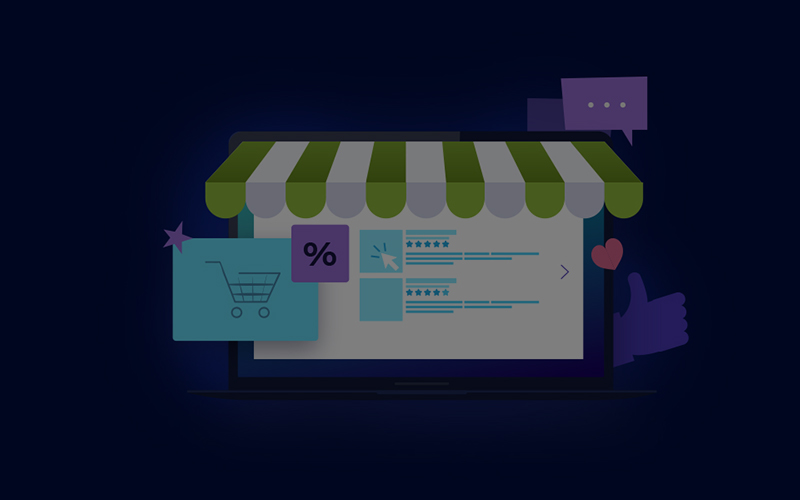What is B2C ECommerce?
B2C eCommerce has steadily risen since its inception sometime after the dot-com boom. Consumers prefer to shop online because it is extremely convenient. This need for convenience, coupled with the fact that starting an eCommerce store is easy (a Shopify site can be set up in a day), has accelerated B2C eCommerce growth over the years.
But taking a step back, what exactly is B2C eCommerce?
B2C, or Business-to-Customer, is a model where a business directly caters to its end-user, the customer. Nike sells shoes directly to consumers who buy and wear them and is an example of the B2C model. It differs from the B2B model where businesses cater to other businesses, like IBM providing computing services to CitiBank, both of whom are businesses.
When a B2C company sells its products online, they engage in B2C eCommerce.
B2C brands generally have a higher sales volume due to their smaller sales cycles (compared to B2B companies). This coupled with the global reach that selling online provides, makes B2C eCommerce an extremely lucrative business for brands. The growth marketing strategies available today help brands accelerate sales, which is another reason for brands to get into B2C eCommerce.

Also Read:
Benefits of B2C eCommerce Marketing


These are the top advantages of B2C commerce:
A mom-and-pop store running out of their home garage can today cater to a global audience thanks to B2C eCommerce. Businesses getting into B2C eCommerce get the advantage of the internet’s global reach. Through channels like a website and social media, every B2C eCommerce store can sell to anyone across the globe irrespective of their size or location.
Of course, they will need to invest in growth marketing tactics to ensure their products are getting a widespread reach, and they may need to invest in hiring a growth marketing agency to get the best results.
B2C brands traditionally needed to operate out of brick-and-mortar stores. Consumers wanted to walk into a physical store, check the product, and only then make a purchase.
Since the worldwide adoption of smartphones, computers, and the internet, most consumers have switched to online shopping. In fact, over two billion people purchased goods or services online in 2020, according to a report by Statista.
This has allowed B2C brands to cater to their consumers over the internet and eliminate physical stores, drastically reducing physical overhead costs. Businesses using models like dropshipping and marketplaces further reduce overhead costs by eliminating the need for product storage altogether.
B2C eCommerce brands engage in end-to-end digital marketing. The advantage of running all marketing activities digitally is that businesses can track all marketing data and analytics and then use this data to make informed decisions to improve marketing activities.
Data can be analyzed to determine which campaigns attract the most consumers, which channels drive the most sales, which platforms provide the highest ROI, etc. This information helps B2C eCommerce brands funnel their marketing budgets and efforts in the right direction.
Ensuring all marketing platforms are appropriately configured is key to collecting accurate data. Reach out to a growth marketing agency if you aren’t tech-savvy and don’t know how to do this correctly.
B2C eCommerce brands engage with consumers digitally, from the first point of contact until the sale is made. Just like in digital marketing, engaging with customers online gives businesses huge amounts of customer data that they can use to better profile their ideal customer.
By studying demographic data like geography, age, gender, and data like preferences and interactions, brands can draw a clear picture of what their ideal customer looks like. This allows them to improve their marketing and advertising targeting and reach out to a more niche audience that is likely to engage with their brand and convert.
-
Local Stores Get a Global Audience
-
No Physical Overhead Costs
-
Complete Marketing Control
-
More Customer Data for Better Profiling
Concept of B2C Dropshipping


Dropshipping is a popular order fulfilment method for B2C eCommerce. In this model, the B2C store sells products without actually keeping the products in stock.
When a customer purchases from a B2C store, the order request goes to a third-party manufacturer or vendor of the product who packs and ships the product to the customer directly. However, the branding and packaging on this order are of the store’s brand, so to the customer, the product has come from them.
In this model, the seller does not have to handle the product at all, and their ownership is reduced to just the online store, eliminating the need for a warehouse or management of physical products.
Dropshipping is a great model for B2C eCommerce brands that are just starting out. Here are some of the benefits of dropshipping:
- Minimal starting capital
They don’t need to invest in a store, warehouse, or purchasing stock. Their only expenditure is on a website. - Easy to start –
Brands just have to find reliable vendors or manufacturers and have a website developed, and they are ready to go. - Little to no overhead –
Dropshipping brands don’t need a warehouse or even a physical store reducing physical overhead. - Work from anywhere –
There is no geographical limitation for the B2C store; they can run their businesses from anywhere. - Large inventory –
The B2C brand can sell any product they want as long as they have a vendor or manufacturer who will fulfil the order. A store can sell apparel and electronic products from a single store. - Scalability –
Since external parties handle the order processing and shipping, the store can increase the stock count and products easily and quickly.
The only area the B2C store will have to focus on will be marketing.
Marketing Strategies for B2C eCommerce


No matter which model you use – in-house product stocking, dropshipping, or marketplace shipping, marketing your brand and online store is completely your responsibility. Here are some digital marketing strategies that will help you increase brand reach and sales:
SEO
Search Engine Optimization is still extremely relevant today. Organic traffic is free and sustainable, and brands should invest in SEO. Search Engine Optimization involves optimizing your website through content and technical improvements to rank higher on SERPs for brand-relevant keywords.
Start by finding keywords that are relevant to your brand and have medium to low competition (especially if you’re starting out). Next, optimize content across the site to cater to these keywords. Lastly, improve website speed.
SMM
Social Media Marketing is the next best digital marketing strategy that B2C eCommerce brands can use. Social media sites get huge traffic today. A 2020 report by HootSuite stated that Instagram advertisers could reach a youth audience of 83 million.
Social media users are looking for visual stimulation. Photos and videos get more engagement than any other format online today. Brands can leverage this fact and showcase their products through images and videos on social media channels.
Blog Marketing
B2C eCommerce stores with less content (and more images) on their website sometimes find it hard to rank on search engines due to low textual content. These brands can use blogs to optimize content and improve their ranking on SERPs.
PPC
Pay-Per-Click marketing is a great strategy for brands to drive traffic to their store when organic methods like SEO are not working (or are slow). Brands can run PPC campaigns on multiple online platforms – Google search, Facebook, Instagram, LinkedIn, etc. Depending on your budget, you can use PPC campaigns to garner huge visibility and traffic to your website.
Mobile-First Campaigns
Globally, 68.1% of all website visits in 2020 came from mobile devices. Desktops drove 28.9% of visits, while 3.1% of visitors came from tablets.
Because users are more active on mobile, platforms like Google search emphasize being mobile-first. A mobile-optimized website will be given preference on SERPS over one that is not (with other factors constant).
To make sure all your digital marketing efforts, organic and paid, get the best results, you should tailor your website and campaigns to be mobile-friendly. It is actually best to design separately for mobile.
Getting Started with Digital Marketing
The strategies listed here need time and skill for best results. These are also just a few of many strategies that B2C eCommerce brands can use.
Marketing can be overwhelming for new and established brands, and outsourcing growth marketing agency is often the better choice, one that drives the best results.
Amura Marketing Technologies is a leading marketing service and MarTech solutions provider in India. We specialize in 360-degree digital marketing solutions for eCommerce businesses. If you’re looking to perfect digital marketing, talk to us, and we’ll have a specialized strategy tailored for your B2C brand.
